Podcast
Questions and Answers
What is the value of the variable "final_result" when the function is called with "a" equal to 5 and "b" equal to 3?
What is the value of the variable "final_result" when the function is called with "a" equal to 5 and "b" equal to 3?
- 14
- 10
- 4
- 8 (correct)
Which line of code represents the assignment of a value to a variable using the "+" operator?
Which line of code represents the assignment of a value to a variable using the "+" operator?
- int b = 3
- return final_result
- final_result = a + b - 2 (correct)
- a = 5
Assuming the types are correctly matched, which of the following expressions will evaluate to True?
Assuming the types are correctly matched, which of the following expressions will evaluate to True?
- a > b (correct)
- b >= a
- a != b (correct)
- a == b
What is the purpose of the "return" keyword in this code snippet?
What is the purpose of the "return" keyword in this code snippet?
Flashcards
Image Analysis
Image Analysis
Examining visual data to understand its content and structure.
Data Visualization
Data Visualization
The graphical representation of information and data.
Iconography
Iconography
The use of symbols and images to convey messages within visual content.
Graphic Design Principles
Graphic Design Principles
Signup and view all the flashcards
Visual Hierarchy
Visual Hierarchy
Signup and view all the flashcards
Study Notes
Heat Energy
- Heat energy is caused by the movement of particles in a substance.
- The faster the particles move, the more heat energy they generate.
Conduction
- Heat transfer through direct contact between materials.
- Example: a metal spoon heating up in hot soup.
Convection
- Heat transfer through the movement of fluids or gases.
- Example: warm air rising and cool air sinking in a room.
Radiation
- Heat transfer through electromagnetic waves.
- No medium is needed for heat transfer.
- Example: heat from the Sun reaching Earth.
Light Energy
- A form of electromagnetic radiation.
- Visible to the human eye.
- Composed of particles called photons that travel in waves.
Transmission
- Describes how much light and sound waves can pass through something.
Reflection
- Occurs when waves (light or sound) bounce off surfaces.
Refraction
- Occurs when a wave (light or sound) changes direction as it passes from one medium to another.
- This change in direction is due to a change in the wave's speed.
Absorption
- The process by which energy (from light or sound waves) is absorbed by a material or surface.
- This absorbed energy is converted into another form of energy, typically heat.
Diffusion
- The spreading or scattering of energy (light or sound) as it moves through a medium or after interacting with a surface.
Studying That Suits You
Use AI to generate personalized quizzes and flashcards to suit your learning preferences.




